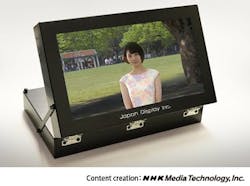JDI and NHK-MT create 17 inch light-field display that allows 3D video without glasses
Japan Display Inc. (JDI) and NHK Media Technology (NHK-MT) have added video playback to a 17.0 in. light-field display that has been under joint research and development between the two companies (the display was previously announced in a non-video form); as a result, they have realized a next-generation 3D video display that can be viewed from any point without glasses. (Light-field technology can also be used to enable cameras to capture 3D information.) The two companies plan to start mass production of this product during the FY2019 period of April 1, 2019 through March 31, 2020.
Note to the Laser Focus World audience: while the two-month lag between the time of JDI's actual announcement and the time we discovered it is far longer than we normally allow for news postings, this (light-field video) is significant enough for us to post it anyway—and to add some clarification as to the actual resolution of this display. The light field display is based on JDI's 17 in. 8K LCD and reproduces the reflected light from an object that corresponds to the actual visible position, thereby realizing natural-looking images without the need for 3D glasses. However, the 3D display itself has a resolution that is lower than 8K, as explained below.
Resolution of a light-field display
A true light-field display is based on optically combining multiple light-field images arranged in a tiled pattern on a 2D display into a compressed pixel array format. As a result, the areal resolution of the display is reduced by a factor of the number of separate parallax views created by the display.
Although this number is not given by JDI, we can provide an example: if a light-field display with both horizontal and vertical 3D capability had 40 separate parallax views, its areal resolution would be reduced by a factor of 40. An 8K display has 7680 × 4320 pixels, or 33 megapixels; the light-field version would thus have 40 times less, or 829,440 pixels. At the same aspect ratio as the 8K display, the actual spatial resolution would then work out to be 1214 x 683 pixels. (Note: this is only an example; the JDI display likely has a number of separate parallax views that is different from 40, and thus a different resolution.)
JDI says, "With this system it is possible to reproduce an 8K light field video by using a practical playback device. Using the latest digitizing and computer graphics production technologies, combined with digital content compressed with newly-created nonlinear algorithms, the system provides unprecedented representation of natural images." This means that an 8K input with tiled images is optimally massaged by an algorithm to be viewed in the light-field display's reduced resolution.
Another note: if JDI and NHK-MT could manage at some point to eliminate the bezels on this device, the displays could be tiled, which would remove the limits on resolution imposed by the light-field technology.
JDI and NHK-MT expect this display to be used in applications such as digital archiving, education, medical fields, and so on.
Source: http://www.j-display.com/english/news/2018/20180517.html
About the Author
John Wallace
Senior Technical Editor (1998-2022)
John Wallace was with Laser Focus World for nearly 25 years, retiring in late June 2022. He obtained a bachelor's degree in mechanical engineering and physics at Rutgers University and a master's in optical engineering at the University of Rochester. Before becoming an editor, John worked as an engineer at RCA, Exxon, Eastman Kodak, and GCA Corporation.

